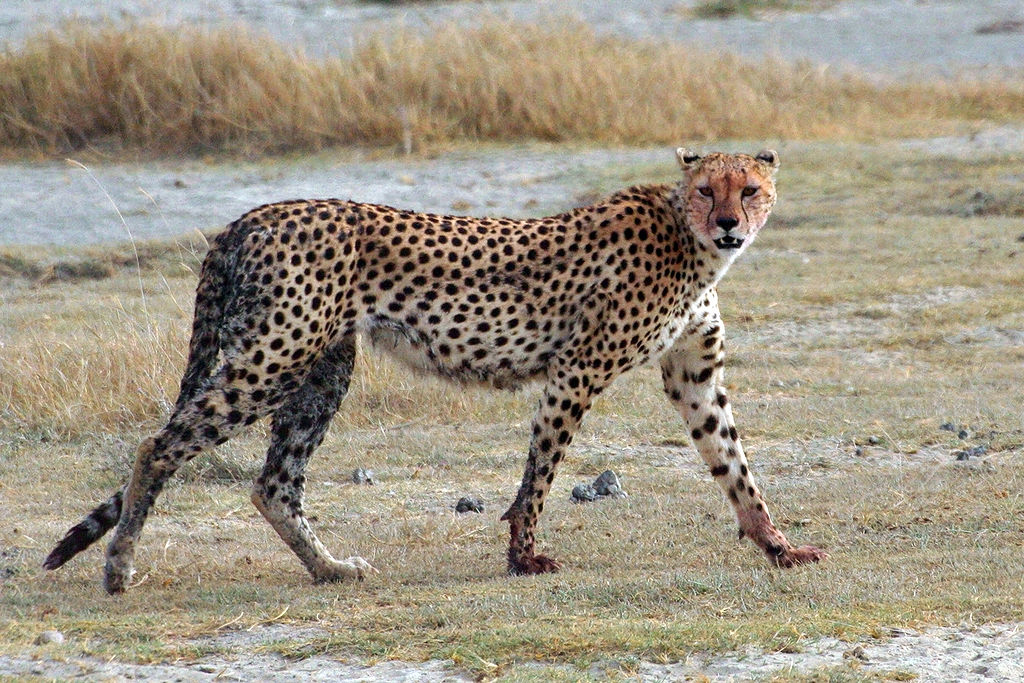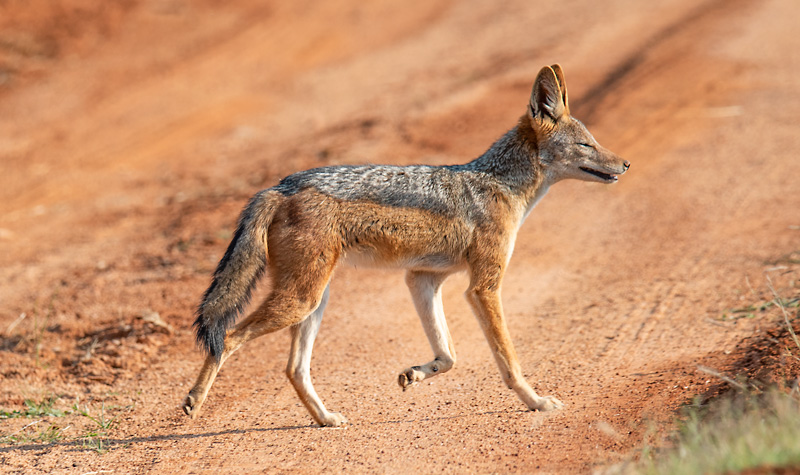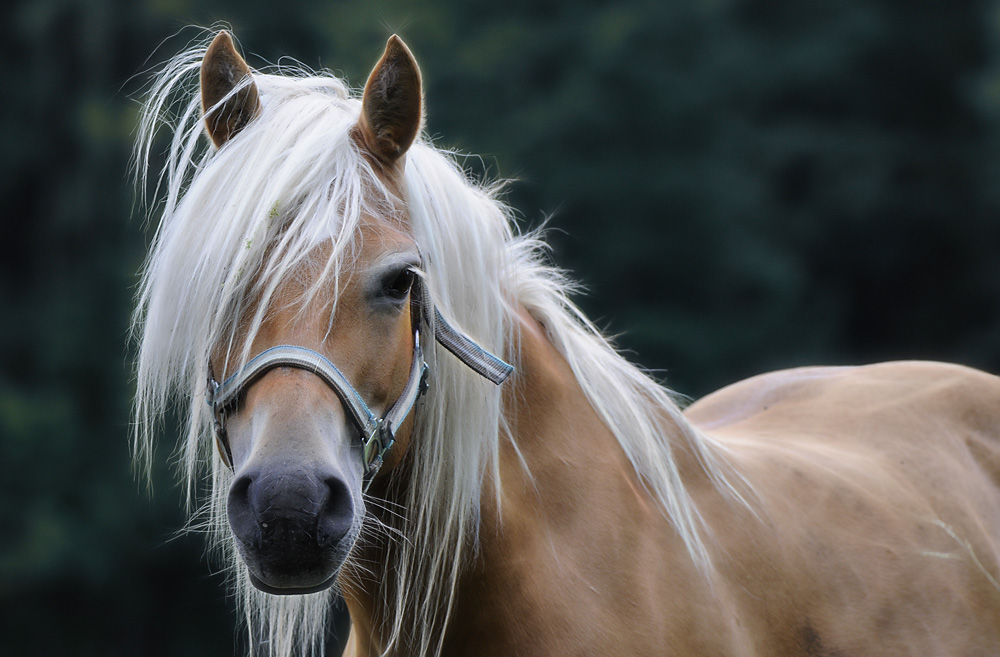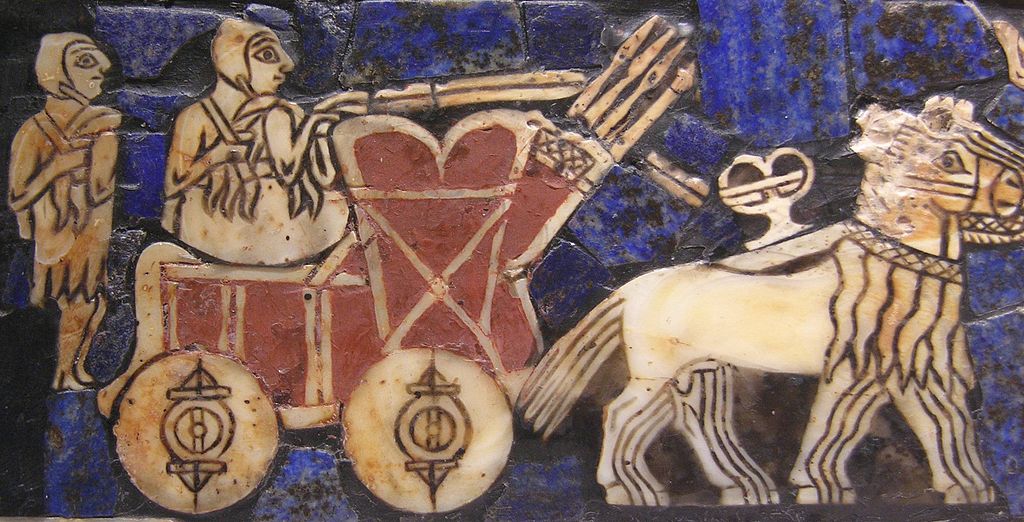Once upon a time our ancestors climbed down out of the trees and ventured into the dry savanna. They might have a good view of the area standing on two legs, but they were at a hopeless disadvantage when it came to speed, agility and power. The biped’s bare hands were no match for giant fangs and razor-sharp claws, or for the superior strength and the killer instinct of the natives. And yet it was possible to find ways to overcome slowness and lack of power.
How man got his upright walk
They say the land and climate changed, that the forests receded and that we had to go farther and farther afield to find something to eat. In this new, flat world an ape-like creature stood upright and began to hunt for food on two legs instead of four. According to the paleontologists Peter Rodman and Henry McHenry, two-legged locomotion caught on for the simple reason that it burned less energy. Whether on two legs or on four, our ape cousins needed much more energy on the ground as we do. This could prove an impressive experiment with chimpanzees performed by anthropologist Michael Sockol of the University of California and his colleagues. Measurements on a treadmill showed that human walking needs 75 percent less energy than chimpanzees walking. This is true for walking on two or four legs. Crucial to the much lower energy consumption of walking of humans are the step length and the active muscle mass.Thus, the energy consumption increases with shorter steps and increasing muscle mass. This result suggests that the origin of biped walking of humans is due to a more favorable energy consumption.
Other scientists say that this new gait developed because we were busy using our hands or because it made it easier to spot enemies in the flat countryside. For the anatomy expert Owens Lovejoy, sex was the prime motivation for moving upright. The males used their hands to bring food home which they then traded in with the females for sex. The reason that this «deal» could work at all was because the females weren’t able to move far enough afield to feed their young well. Poor nutrition meant slow maturation and in turn a low birth rate, perhaps one child in four years, for as long as the female was busy raising young it wasn’t available for mating. The male that could move upright to gather nuts or animal protein could provide the female with more time for its young, shortening the time needed for child-raising and ensuring that it was ready to mate again sooner.
Annother theory: According to the behavioral scientist Carsten Niemitz the stay near the banks of water bodies and the search for food in the water was the main reason for the development of upright walking.
Our fruit-picking ancestors had quite a tough stand in the savanna. They lacked the dangerous weapons of their opponents and, as we just said, they were hopelessly slow. In an imaginary foot race between hunters and prey over a short distance, man would come in almost last.
As far as bodily abilities, acuity of the senses and – above all – speed go, our earliest upright ancestors had about as much of a chance of winning the race for survival as a VW bug from the Sixties has at winning a modern Formula One race. Man would probably have come in quite literally «dead» last if his new skill of walking upright had not been accompanied by another development: a brain that grew and grew. Three million years ago it still had a volume of about 500 cubic centimeters, one million years later around 800, and today an average of 1350. According to anthropologist Robert Martin of the University of Zurich, this exceptional development was only possible because of man’s ability to acquire more high-calorie food. Energy is essential for the growth and function of the brain. In an adult male the brain makes up only 2% of the total body weight, but uses approximately one fifth of his energy resources. The brain of a newborn even needs more than half of the available energy, even though it only makes up about one tenth of the baby’s total weight. If it had not been accompanied by a progressively better diet, says Professor Martin, the enlargement of the brain over the course of evolution would not have been possible. Only by walking upright were we able to gather the calorie-rich food that we needed. Other researchers speculate that instead the enlargement of the brain was connected with life in a community. Only a creature with a highly developed brain is able to communicate, plan and coordinate actions and correctly interpret the behavior of another group member.
Survival in the savanna
Whatever triggered this gigantic increase in brain mass, the extra smarts allowed the biped to gradually develop «intelligent» solutions to compensate for his slowness. He threw stones deliberately, and he invented the spear. In the process he developed a crucial survival skill that his primate relatives do not possess – the ability to aim precisely. Early man may not have been able to keep up as a sprinter, but he had some considerable talents that racked up important points in the race for food. His excellent long-range vision allowed him to spot circling vultures high in the sky and to accurately gauge their distance. At this point he could take advantage of his superior endurance and hope to make it to the carcass before the short-sighted lions. It was a race against time. If he was lucky enough to arrive at a big animal cadaver first, he could grab his sharp-edged flint, slit open the leathery skin that would have been too tough for a vulture’s beak, and help himself. At least this is how the evolutionary biologist Josef Reichholf paints the scene. Physically, early man may have been no match for the predators of the wilderness, but he was able to close the gap by using his brain in the race to the carcass.
Animals at the service of Homo sapiens
Of course, it’s possible that our hunting ancestors weren’t left to shift entirely for themselves. If we can believe the famous behavioral scientist Konrad Lorenz, early man was «backed up» by jackals. In a kind of hunting party, these small, fleet-footed predators flushed out and then chased and cornered the prey. The human hunter took over the job of killing the much larger animals, and then rewarded his «hunting dogs» with a juicy hunk of meat. Thousands of years would pass before man really went to the dogs, though, domesticating it and training it to sniff out his prey, track it and bring it to bay. It wasn’t until 10 or 15 thousand years ago that dogs were tame enough to take over such complicated tasks in teamwork with men. With a combination of sprinting speed and endurance that is rare in the animal kingdom, this four-legged creature with the cold snout became a valuable helper for the hunter, who was now armed with bow and arrow. The excellent range of the arrow and the reliable help of his four-legged companion effectively made up for the prey’s advantage of speed.
The history of the slow upright walker is also a history of his helpers and the tools that allowed him to catch faster prey and to protect himself against his enemies: the spear and arrow, his hunting companion the dog, and the horse, which we have not mentioned yet. At first the horse was just an item on the menu just like any other game animal, and it provided a good hide. The hunters threw spears at it and drove it into pitfalls. Many millennia would pass before man would mount a horse and ride. There is no evidence that horses were actually ridden until the second millennium B.C. As soon as men finally climbed onto the back of a horse, however, they were unstoppable.
This newly acquired speed gave the nomadic tribes incredible power and helped them spread out. Armed with spears, short-bladed swords and bow and arrow, the Huns swarmed into China, pillaged and slaughtered, and finally disappeared again as quickly as they had come. The largest uninterrupted imperial territory in history was conquered on the back of a horse. The Mongol Empire, the realm of Genghis Khan and his heirs, stretched from Lake Bai¬kal to Vietnam and from the Pacific Ocean to the Adriatic Sea.
On horseback, man had the speed, endurance and strength to break through the horizon and discover new territories. Was this the moment when he suddenly felt free like he never had before, free from the fetters of slowness and free from the close confines of his ancestral home? His big, strong companion made the world smaller and more beautiful. It must have been a joy to cross it at a gallop and watch it fly by. Looking down from his perch the rider must have sensed his superiority over all the others trudging along on foot. Did this champion in his new-found glory feel strong enough to topple the very gods from their pedestals?
Horse and cart team up
We all know the old saying, «Don’t put the cart before the horse.» But history sometimes follows different rules. In fact, the cart seems to have been invented long before the horse became a draft animal, probably in Mesopotamia, the cradle of civilization between the twin rivers Euphrates and Tigris. The clever Sumerians who lived there 5000 years ago built cities and streets, and invented writing and the idea of the division of labor. They had been also credited with having invented the wheel. We do know that the Sumerians built different types of heavy, two-and four-wheeled wooden carts. At first these carts were pulled by oxen. Later they were drawn by donkeys and above all by mules. But today, it is assumed that the cart was invented simultaneously in differernt places (e.g. Black Sea region, Mesopotamia and in the foothills of the Alps).
It is no coincidence that the cart began its rapid ascent in the prosperous realm of the Sumerians. Even if some scholars maintain that the rolling sledge was originally a cult object, a holy machine built to carry statues of the gods, this earliest of all civilizations certainly needed an easy way to transport agricultural products. Because the Sumerians had settled in densely populated cities, they had to plant everything outside of town and then bring it back inside. They also needed to transport building materials and stones from far away, for the alluvial plains where they had settled did not provide the right raw materials. Even if Sumerian trade was originally motivated by this lack of building supplies, it was soon given another strong driving force: the desire for riches. In exchange for agricultural products the Sumerians acquired not only the building materials they needed, but also treasures like silver, gold and precious stones. The distances covered were immense – and dangerous, too, for they attracted brigands and thieves.
To make a long story short, the Sumerian cart began its winning streak with the advent of town life. Its introduction completely revolutionized transportation and influenced the course of history. At this point the horse did not yet play much of a role as a draft and riding animal. Oxen and donkeys pulled the heavy loads, and the job of pulling the noble war wagons was reserved for a cross between the fleet onager (a wild ass) with the tireless domestic donkey. Later this «honorable» task fell to the mules. It was not until the 18th century B.C. that the meteoric rise of the horse began in Mesopotamia. It was tamed and harnessed to a new type of wagon, the light war chariot, with which it charged the foot soldiers used by everyone else. The superiority of this terrifying machine of war lay in its light construction. All superfluous weight was pared away by using the newly invented spoked wheels and a smaller rider’s platform consisting of just a floor and a curved dashboard. Driver and archer formed a team. While one whipped the horses through the infantry ranks of the opponent, the other shot at the enemy with his arrows. As new research revealed the first war chariots obviously have not been built by the Sumerians, but by steppe people in Western Siberia four thousand years ago. War chariots were produced in all the cultures of the ancient world, and some of them continued to refine it.
The heyday of the rider
In spite of all this, the glory of the fleet war chariots faded over the centuries. War took on a new face. The mounted warrior that had developed on the steppes was far more agile than the sluggish vehicles of the elite and was thus more effective. Some researchers maintain that the victory of the rider over the chariot was ultimately a matter of superior technology. The newly invented snaffle bit made it possible to rein and thus better control the horse. Others attribute the enormous success to the breeding of more powerful horses that were finally able to carry the load of a rider. Regardless of which explanation is correct, the days of the chariot driver were over. Many of them only gradually – and grudgingly – traded their platform for a seat on the back of a horse. The aversion of the chariot drivers toward fighting from the saddle is understandable if one keeps in mind that, as archeologist Hans-Georg Hüttel points out, in the old elitist chariot societies riders belonged primarily to the lower classes. Grooms rode – noblemen drove!
But what became of the horse-and-cart combo? It is puzzling that Homo sapiens took all of two thousand years to figure out the right way to harness horsepower to draw his loads. A truly brilliant idea had to come along to break the monopoly of the ox in the transportation business. All it took was to free the horse from the stranglehold of the yoke strap and replace everything with a comfortable horse collar. A primitive forerunner, the breast strap, was probably invented in China in the fourth century A.D. but did not appear in Europe until the early Middle Ages. The historian Wilhelm Sandermann counts this invention among the greatest achievements of humankind, because once freed from the yoke, the horse was able to accomplish much more than the ox. A team of horses could make about 40 kilometers in a day, while oxen were only able to make 25. Both agriculture and transportation benefited enormously from the newly acquired draft power.
In the Middle Ages a gentlemen rode on horseback. Only the aged and sick, prisoners and women traveled in carts. Until modern times, according to historian Norbert Ohler, the riding horse was the status symbol of nobility, knights and bishops. The great majority of the population could barely afford bread, let alone a horse. It was «a serious competitor for food,» says Ohler, «less modest in its demands than the donkey, for it ate oats, a staple food of the lower classes.»
Referencies






